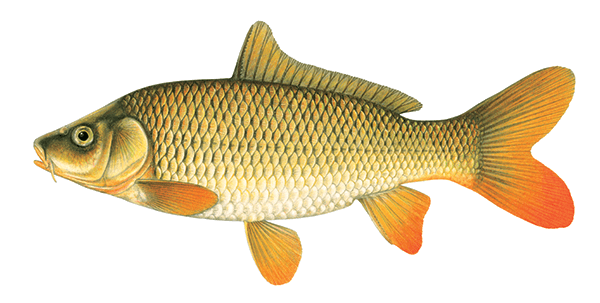The web Browser you are currently using is unsupported, and some features of this site may not work as intended. Please update to a modern browser such as Chrome, Firefox or Edge to experience all features Michigan.gov has to offer.
Common carp and suckers
Suckers
Scientific name
Catostomus commersonii (white sucker)
Catostomus catostomus (longnose sucker)
Identification
Single soft-rayed dorsal fin, sucking mouth with no barbels, long cylindrical body. The white sucker has coarser scales that become smaller near the head. The longnose sucker has fine scales all over its body. The mouth of the longnose sucker is set back from the tip of the underside of its snout, hence its name "longnose". Longnose suckers often develop a rosy red color along their sides when spawning, similar to the coloration of rainbow trout. White Suckers may occasionally develop a dark stripe along their sides during the spawning run.
-
Fishing
-
Diet
-
Life history
-
Background information
Suckers are among the first fish to attract attention in the spring as they begin their upriver spawning runs, often before the ice is off of inland lakes. Anglers line the banks, fishing the bottom in the deep holes below riffles with earthworms. Suckers can be found in virtually all the state's rivers, including most trout streams. In some places they can be taken with dip nets. They are often smoked or ground and made into patties or cakes for the table. Anglers wading the flats as they would in the Caribbean for bonefish, sight-fish for common carp using wet flies tied to resemble crawfish or nymphs. A number of guides now often charters for common carp fishing in the Great Lakes bays with fisheries in Grand Traverse Bay and Saginaw Bay of special significance. Because common carp regularly weigh into double digits — the state record is 61 ½ pounds — heavy rods and strong leaders are required.
Both common carp and suckers can be taken by spear or bow and arrow from the Great Lakes and non-trout inland waters.
Both the white and longnose suckers are bottom feeding fish.
Life history
White and longnose suckers ascend rivers to spawn over gravelly bottoms or in the absence of rivers they will spawn on gravelly shoals in lakes. White sucker runs may begin in mid-March in southern Michigan, or as late as early May in the north. Longnose sucker runs are usually later, possibly because it takes the deeper waters of the Great Lakes longer to warm up. Longnose suckers ascend rivers from mid-April to early May, depending on latitude. Maximum life expectancy for white suckers appears to be 17 years; it can be as long as 22–24 years for the longnose. Whites usually grow to be 12–20 inches long, while the longnose grow to 15–25 inches.
Suckers are also found statewide in warm-water rivers and inland lakes. Longnose suckers prefer cold, deeper waters of the Great Lakes and have been found as deep as 600 feet in Lake Superior. The white sucker goes by a number of other names, including common sucker, coarse-scaled sucker, brook sucker, gray sucker, mud sucker, sucker, mullet, black mullet, slender sucker, june sucker, and white horse. The longnose sucker is sometimes called the sturgeon sucker because of its pronounced snout.
Carp
-
Scientific name
Cyprinus carpio (common carp)
-
Identification
Light gold to dark brown in color with large scales covering entire body. Fins are often reddish and they do not have true spines. They have a triangular head with a blunt snout and thick nose plate. Average size is from 15 to 32 inches and 4 to 31 pounds, depending on the water. They can be distinguished from buffalo and suckers by the little barbels on the corner of their mouth
-
Diet
Common carp eat a variety of foods including plants, insects, crustaceans and other benthic species.
-
Life history
In Michigan, they are found in the Great Lakes, large inland lakes and reservoirs, large and small rivers, swamps, canals and drains. They generally prefer shallow, muddy habitats with aquatic vegetation and they spawn during spring. The spawning and feeding behaviors of common carp increase the water turbidity by disturbing the bottom sediments.
-
Life history
In Michigan, they are found in the Great Lakes, large inland lakes and reservoirs, large and small rivers, swamps, canals and drains. They generally prefer shallow, muddy habitats with aquatic vegetation and they spawn during spring. The spawning and feeding behaviors of common carp increase the water turbidity by disturbing the bottom sediments.
-
Background information
Originally from the Caspian Sea region, common carp were first introduced to ponds and springs in the U.S. in the mid-1800's by entrepreneurs supplying local fish markets. By the 1880's the U.S. Fish Commission was actively stocking rivers and streams across the country with tanker-loads of common carp imported from Germany, hoping to provide an abundant food source to rural populations. Common carp have long been considered a nuisance species in Michigan, but they should not be confused with invasive carp species, including bighead, silver and black carps. Currently, there is no evidence that bighead, silver or black carps have colonized or are present in any numbers in the Great Lakes.
